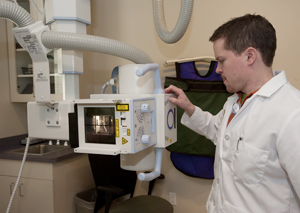Washington University in St. Louis students who need diagnostic X-rays no longer have to leave campus in search of an imaging facility. Through a new partnership between the Habif Health and Wellness Center and the Mallinckrodt Institute of Radiology (MIR), students now can have those scans taken on the South 40.
Located in the Nathan Dardick House, WUSTL’s Habif center provides a wealth of medical and mental health services to nearly 10,000 undergraduate and graduate students. On average, the center treats 80 students a day for a variety of reasons.
To make quality medical care even more accessible for WUSTL students, the Habif center recently installed on-site imaging equipment and hired radiologic technologists. Radiologists at MIR will interpret the scans and provide feedback to center clinicians.
“This is a great enhancement to the comprehensive medical services that we provide to the student community of Washington University’s Danforth Campus,” says Alan Glass, MD, assistant vice chancellor and director of the Habif center.
“Thanks to this significant collaboration between the Habif Health and Wellness Center and the Mallinckrodt Institute, our students will have convenient access to premier imaging services at a reasonable cost,” he says.
Advanced technology
The center’s new digital radiography system is designed for all standard examinations — from the head and spine to the abdomen and extremities. The system provides brilliant images while delivering the lowest radiation dose to patients.
With advanced technology, images can be magnified and rotated on a computer screen and dark images can be made lighter — eliminating the need for repeat scans. The digital images are sent via secure lines to radiologists at the School of Medicine.
While most interpretations will be returned to the center within three to four hours, it is possible to get immediate results when necessary and for center physicians and radiologists to discuss cases in real time.
“I can see the digital images on my computer at the hospital, and we can talk through it on the phone,” says Michael W. Penney, MD, director and chief of radiology at Barnes-Jewish St. Peters Hospital. “That’s the kind of service we want to provide. The Washington University faculty wants to take care of its own. Why would we want our students to go to some other place?
“We know everyone’s time is valuable – the students’, the physicians’, the family members’ — and we believe this will lead to better outcomes.”
R. Gilbert Jost, MD, the Elizabeth E. Mallinckrodt Professor of Radiology, head of the Department of Radiology at the School of Medicine and director of MIR, says he is pleased that the Medical and Danforth campuses are partnering for the benefit of students.
“The Radiology Department at Washington University is considered to be among the best of its kind in the world,” Jost says.
“As a result of our partnership, our Washington University students will be offered radiology services that are second-to-none,” he says.
Comfort, convenience & efficiency
Interpretations, once read, are sent back in a digital format and loaded into students’ electronic health records. All the while, students, who are worried, sick or injured, will be receiving care from university health professionals in a familiar, comfortable setting.
If advanced testing, such as an ultrasound, CT scan or MRI, is required, the student will be examined on the Medical Campus. The center will work with the medical school to schedule appointments in a timely fashion and make specialist referrals.
Debra S. Harp, Habif’s director of administration, estimates the center will perform five to 10 exams a day. “We’re projecting 1,200 orders a year, but that number may go up,” she says.
“Now, if a student comes in with a respiratory illness, we can rule out pneumonia right away and prescribe treatment accordingly,” Harp says. “Before, we had to watch and wait or send the student to an area hospital.
“If a student comes in with back pain, now we can take a quick film and rule out some causes of the pain and perhaps save additional imaging,” she says. “The radiation dose is extremely low. This is just another piece of the quality care that we provide.”

With two radiologic technologists, Christina Sanford and Tony O’Rourke, on staff, it is possible for students to get X-rays any time the center is open.
Hours are 8:30 a.m.-5 p.m. Monday through Friday. A nurse advice line — (314) 935-6666 — is available when the center is closed.
“This was a significant investment in financial and human resources on the part of the university, which will contribute greatly to the health of our students and their dependents,” Glass says. “I am extremely grateful to Washington University for the focus that we place on the health and wellness of our students.”
In addition to imaging, the Habif center offers a broad range of services, including primary care medicine; mental health; health promotion; allergy injections and immunizations; lab work; nutrition consults; a pharmacy; physical therapy; women’s health; testing for sexually transmitted diseases; sexual violence counseling; and travel medicine (pre-travel physicals and immunizations).
For more information, visit shs.wustl.edu.